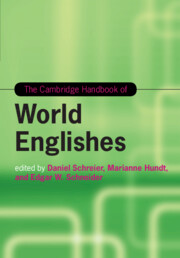Book contents
- The Cambridge Handbook of World Englishes
- Cambridge Handbooks in Language and Linguistics
- The Cambridge Handbook of World Englishes
- Copyright page
- Dedication
- Contents
- Figures
- Maps
- Tables
- Notes on Contributors
- 1 World Englishes: An Introduction
- Part I The Making of Englishes
- Part II World Englishes Old and New
- Part III Linguistics and World Englishes
- Part IV Current Challenges
- 25 Norms and Standards in World Englishes
- 26 Identity and Indexicality in the Study of World Englishes
- 27 The Politics of World Englishes
- 28 World Englishes in the Media
- 29 World Englishes and Transnationalism
- Index
- References
28 - World Englishes in the Media
from Part IV - Current Challenges
Published online by Cambridge University Press: 16 December 2019
- The Cambridge Handbook of World Englishes
- Cambridge Handbooks in Language and Linguistics
- The Cambridge Handbook of World Englishes
- Copyright page
- Dedication
- Contents
- Figures
- Maps
- Tables
- Notes on Contributors
- 1 World Englishes: An Introduction
- Part I The Making of Englishes
- Part II World Englishes Old and New
- Part III Linguistics and World Englishes
- Part IV Current Challenges
- 25 Norms and Standards in World Englishes
- 26 Identity and Indexicality in the Study of World Englishes
- 27 The Politics of World Englishes
- 28 World Englishes in the Media
- 29 World Englishes and Transnationalism
- Index
- References
Summary
Media, especially those that are free, represent an important site for Englishes to display tension between local and global identities. There is a preference for international media standards, and these are closely associated in name with media (“broadcast standard English,” “BBC English,” etc.). At the same time, media providers attempt to localize English usage for various effects, including identity formation. Media Englishes, therefore, adopt and codify much of the “authority” of standard English and, at the same time, use nonstandard Englishes to construct “authenticity” within media performances. The chapter surveys the large number of media studies conducted from the World Englishes perspectives and identifies common themes running through them – most notably, the expression of popular culture identities in various media Englishes and the use of English as a linguistic resource within other media languages. It considers sociolinguists’ traditional rejection of the media as a motivating factor in language change and considers more recent evidence that the media provide positive norms for the acquisition of English across the Inner, Outer, and Expanding Circles of users.
- Type
- Chapter
- Information
- The Cambridge Handbook of World Englishes , pp. 652 - 675Publisher: Cambridge University PressPrint publication year: 2020
References
- 1
- Cited by

